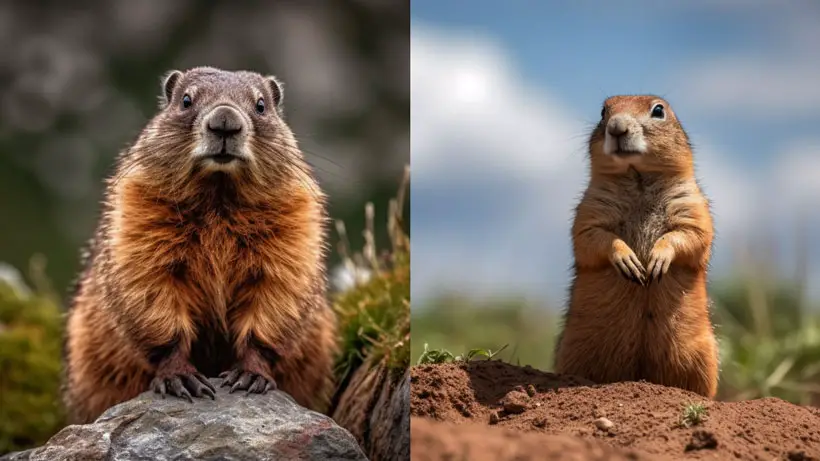Marmot vs Prairie Dog: Behavior, Habitat, and Physical Characteristics
Marmots are medium-sized rodents from the squirrel family and are available in 15 species. Their natural habitat includes meadows, mountainous regions, grasslands, tundra, and forest edges.
Similarly, prairie dogs are ground squirrels belonging to the squirrel family. However, there are only 5 species of prairies, and their natural habitat is open grasslands.
Because of their similarities, it is easy to confuse one for the other, especially if you want to keep either as a pet. So, you might wonder, what are the marmot vs prairie dog differences?
A marmot differs from a prairie dog in size, weight, fur color, and body features. Other differences between the two is their behavior like mating and communication. Their habitat preference is also slightly different.
But wait, there’s more! So, in this article, we will discuss everything there is to know about marmots and prairie dogs’ physical characteristics, behavior, and habitat.
Marmot vs Prairie Dog: Physical Characteristics
Below, we will look at the critical differences between marmots and prairie dogs regarding their physical attributes. Check them out.

Size
Compared to Prairie dogs, marmots are larger in size. Their size ranges from 16 to 32 inches from the head to the tail. This varies depending on the marmot species. For instance, an adult Hoary marmot, the largest species, measures between 24 and 32 inches long.
Typically, the male marmots are longer than their female counterparts.
Unlike the marmots, prairie dogs are small and short-tailed rodents. On average, their body usually grows to be between 12 and 17 inches long. The black-tailed prairie dog is the biggest, measuring between 14 and 17 inches, including the short tail.
Weight
Weight is also one of the many marmot physical characteristics vs prairie dog physical characteristics. Generally, marmots weigh between 4.5 and 24 pounds, depending on the species with males being heavier than females.

These dogs usually achieve their maximum weight in late summer when they gain thick layers of fat to sustain them throughout the winter. During spring, the smallest species typically weigh about 4.5 pounds.
Conversely, the average weight of prairie dogs is between 1 and 3 pounds. This explains their small size.
Fur Color
Marmot’s fur is dense, but its color varies from one species to another. Some species, like the groundhogs, have yellowish-brown to black-colored coats. Others boast reddish brown, a mix of gray and white, or brown-black fur.
However, the fur on the belly is lighter but darker on the head and back areas. On the other hand, the tip of the tail is usually blackish.

On the other hand, the fur color of prairie dogs is a combination of gray, light brown, black, and white. These exotic animals are generally tan, but their back is darker than their stomach.
However, the chin and throat are even lighter than the belly. The tail is black-tipped and buff-colored to blend with the soil’s color.
Body
Marmots have a short and broad head that is flattened. They also come with large eyes positioned close to the head’s top. The neck is short, and the ears are small. These rodents also boast flat, broad noses and long whiskers around the nose, lower jaw, cheeks, and eyes.
On the other hand, prairie dogs boast narrow and pointed heads. They also have large eyes positioned on the sides of the head. The ears are short and hidden under the fur. In addition, these dogs have long whiskers under their short snouts.
How Do Marmots and Prairie Dog’s Physical Attributes Aid Their Survival?
Marmots’ large size enables them to store enough fat to help them survive hibernation for up to 8 months. In addition, their large size helps deter predators. On the other hand, their relatively dark-colored fur makes them hard to be noticed by predators.

And the small size of prairie dogs is one of their best physical adaptations as it makes them more agile than the marmots. Their agility allows them to quickly escape from their predators.
Also, their small size ensures they eat less food than their marmot counterparts. And similar to marmots, their fur is not brightly colored for ease of avoiding detection by predators.
Behavior
This section will focus on any differences or similarities between marmot behavior vs prairie dog behavior.

Mating and Breeding
Typically, male marmots usually mate with one or more females at the same time once a year. They breed in late spring or early summer while still in the den.
Like marmots, prairie dogs also mate once every year with multiple females. The breeding season for these dogs is between mid-March and early April, when the females come out from hibernation.
Territoriality
Marmots live in families or large groups known as colonies and with each colony comprising up to 30 families. The families usually consist of one adult male and female plus several young ones.

Marmots, especially the males, are highly territorial and usually mark their territory boundaries using scent glands. In addition, they may flag their tail to announce their presence.
Prairie dogs live in large groups known as coteries. Each coterie comprises several family groups and each family is made up of a male, several females, and their offspring. Like marmots, the male prairies are incredibly territorial. They usually make a series of barks to warn any intruders on their coteries.
Communication
Marmots communicate with each other either via direct contact by grooming each other or through various vocalizations. For instance, the males may wag their tails to attract the females as they chase them.
In addition, they also communicate via different calls depending on the situation, including chucks and trills. For example, the animals may chirp or whistle to warn others of danger.
Similar to marmots, prairie dogs also communicate with one another via body language and vocalizations. Their vocalizations include a range of chirps, screams, growls, snarls, chatters, barks, and whistles. These dogs also jump-yip to ensure their neighbors are alert.
How Does Marmot and Prairie Dog Behavior Compare or Differ in Captivity & Their Natural Habitat?
First, marmots and prairie dogs in the wild usually mate once a year. However, these exotic animals may breed several times throughout the year in captivity. This is because the conditions in captivity are favorable.

That said, their territorial animal behavior, both in their natural habitat and captivity, is the same. In addition, they use the same vocalizations and body language to communicate.
Marmot Habitat vs Prairie Dog Habitat
Marmots are commonly found in north-central Asia, north of Mexico, the Himalayas, the Kamchatka Peninsula, Eurasia, the European Alps, and northeastern Siberia. Their habitat preferences include:

- Mountainous regions
- Alpine and subalpine meadows
- Forest edges and rocky terrains
- Grasslands
- Tundras and steppes

On the other hand, prairie dogs are native to the grasslands of North America, including:
- Northern Arizona
- Southeastern Utah
- Northwestern New Mexico
- Southwestern Colorado
They usually inhabit open, flat, and dry grasslands with minimal vegetation. Typically, these dogs avoid habitats with less visibility, like tall grassy areas.
Comparing the Differences Between Marmot and Prairie Dog Habitats
So, compared to prairie dogs, marmots have more habitat preferences. Prairie dogs prefer the dry and open grasslands.
However, marmots can inhabit grasslands, forest edges, mountainous regions, meadows, and steppes. Also, they are widely found in many parts of the world, unlike prairie dogs.
What is the Impact of Habitat Loss on Marmot and Prairie Dog Populations?
- Marmots and prairie dogs require extensive, open grasslands for foraging. Therefore, the destruction of their habitat can lead to reduced availability of food and water.
- Also, habitat loss due to climate change or human activities may cause an increased risk of predation for these animals. This is because the marmots and prairie dogs have fewer places to hide from predators.
- Additionally, when their habitat is destroyed, this may lead to climate change.
- Consequently, this may impact the animals by altering their hibernation timing, disrupting their breeding cycles. As a result, their population size may suffer.

FAQs
Now let’s look at frequently asked queries regarding marmot and prairie dog species.
Q: Can marmots and prairie dogs be kept as pets?
Yes, but only in some states. For instance, you can keep marmots as pets in states like Nevada, Wisconsin, Alabama, and North Carolina. Pet ownership of prairie dogs is also permitted in most states like South Carolina, West Virginia, Texas, and Washington.
Q: What should I do if I find a marmot or prairie dog in the wild?
It would help if you did not approach them but observed them from a distance. These animals have wildlife behavior, including being territorial. Therefore, they may become hostile when you enter their territory.
Q: Are there any legal restrictions on keeping marmots or prairie dogs as pets?
In most states, keeping marmots, prairie dogs, or other wild animals as pets is illegal. However, some states allow the keeping of these animals as pets under strict legal regulations. This includes having a state and federal wildlife rehabilitation license.
Conclusion
Most people often mistake marmots for prairie dogs and vice versa. However, these two animals differ in physical characteristics, behavior, and habitat.
Therefore, understanding their physical characteristics, habitat, and behavior is critical if you would like to keep them as pets. This is because some states allow you to keep prairie dogs as pets, but others only allow marmots.
That said, more research should be conducted about these animals to help identify all their potential threats and solutions. Also, human activity should be restricted, protected areas created, and people should be educated about preserving these rodents‘ habitats.




